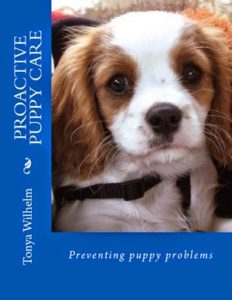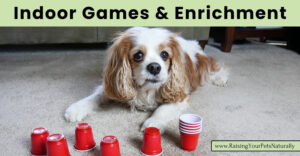Google Adsense—>

Puppy Potty Training Tips

Congratulations on your new bundle of joy! I absolutely love puppies and puppy training. I haven’t found anything I like better than the smell of puppy breath.
Training a puppy is a lot of work. No, really, it is! Puppies go 100 miles a minute, want to put everything in their mouths, zoom around the house, pull on the leash, and potty every 10 minutes. No, really, an active puppy may potty every 10 minutes.
Watch my potty training video and don’t forget to subscribe to my YouTube channel.
I’m in a lot of Cavalier King Charles Spaniel groups, and I’m asked over and over about potty training a Cavalier. People seem to have a lot of potty accidents going on. I’ve written about potty training a puppy in the past, but I wanted to dive deeper into how you can successfully housetrain your puppy.
First, is to have realistic expectations. I’ve seen blog posts and videos on how to potty train your puppy in 5 days. Really? That is nonsense! Potty training a dog to me means a dog holds it until let outside. Obviously, exceptions for medical conditions or way too long left alone. A puppy is like an infant; they are not going to actually be able to do that at an early age. And learning, well, that takes more than 5 days.
The success stories you are reading from your friends, well, they are likely to have had great management and training that you will learn below. Let me explain that better. Dexter, was not potty trained in 5 days, but he only had 2 accidents in the house. 3, if you count the time he had diarrhea in his crate. He wasn’t “potty trained” in the sense that he wouldn’t go in the house if I didn’t take him out, but rather, I took him out all the time and did not give him the opportunity to pee in the house. Let’s dig into the best way to potty train a puppy.

One hundred percent supervision or confined to an area that is small enough that he won’t pee inside. If you are confining your puppy to a relatively large x-pen, he will likely pee in the x-pen. So, that doesn’t work. If the puppy crate is too large, the same thing is likely to happen. Confinement should be a space that he can comfortably stand and lie down inside, but not go off to a corner and pee.

What do I mean by supervising your puppy? You can physically see him, and you are watching him. When he moves, you are completely aware of his actions. You, not your child or your spouse who only half pays attention to him. This may mean that you and your puppy are shut in a room, such as your office, or he’s on his leash and you are taking him room to room with you. Baby gates are another great option, or even large x-pens. Again, eyes on. If you are “finding” potty mistakes, you are not supervising. Seeing a mistake happen would be supervising. Finding a mistake means you were not watching your puppy. By the way, this is temporary, and once potty training and chewing are under control, you can lighten up. Remember when I said puppies are a lot of work?
How Often to Take a Puppy Potty
That depends. My first goal in successfully housetraining a dog is to not have accidents. I recommend taking active puppies out often. Every 15-30 minutes is not unusual. Signs that you should take your puppy out to potty include: waking up, after eating, change in his activity, he’s looking around, he goes towards the door, he just had a good chew, he just romped around, basically after anything active or any change in his behavior. Remember, the goal is no peeing in the house. Don’t give your puppy the opportunity to pee inside.
When your puppy is left home alone in his crate, you can typically expect him to hold it for about 1 hour over his age in months. If he’s 2 months old, 3 hours. 4 months old, 5 hours. Personally, I feel all dogs should have the opportunity to go outside at least every 5 hours, preferably 4. If you work 8-hour days, I would suggest hiring a pet sitter to take your puppy outside and play once or twice a day. Yes, puppies are a lot of work and need contact with humans.

When Will a Puppy Sleep Throughout the Night
Can I say it depends? It does. I recommend crating your puppy in your bedroom if at all possible. This will allow you to hear him stirring or whimpering in the night. Then, you can take him to potty when he stirs. If not, plan on setting your alarm about halfway through the night. Remember in the morning, he should be let outside immediately. Around 6-9 months I start to think my puppy can go all night without needing let outside. Do not limit your dog’s access to water. He should always have access to fresh water unless he has a medical reason.
Taking Your Puppy Potty Outside
Leash that puppy even if you have a fenced-in yard. If your yard is fenced and you truly are not going to leash him, stay right with him. Let me walk you through how I train dogs to potty outside and, in the future, to potty on cue.
When I’m potty training a puppy, I leash him to his harness. I take him to a nice spot (changing spots so he doesn’t get fussy on only peeing in 1 spot) and let him have his 6′ leash length. I don’t follow him around, I just linger within his leash length. Once he’s peed, I tell him how smart he is, give him a tasty treat, THEN we walk around or, if in a fenced yard, unleash. So, he’s getting double the reward. Treat followed by a walk, sniffing. This will speed up the potty process because he’s learning he doesn’t mosey until after potty.
Pooping will usually occur during the mosey walk. Pick up your dog’s poop right away to avoid a future poop eater! If you and your puppy spend a good amount of time outside after peeing, he will likely need to potty again before coming inside.
Doggie Doorbell Training
Nope. I’m not a fan of trying to teach your puppy to use bells. This is my thought process behind the whole concept. One, if you are trying to teach your puppy to go outside and not pee inside, trying to teach him to use the bells is 1 more skill you are trying to teach. But, that’s not even the biggest reason I’m not a fan.
I’m not a fan of demanding dog behavior. By teaching your dog to ring dog bells, you are teaching him that every time he rings those bells, you have to get up and let him outside. Believe me, it won’t be long before he’s ringing those dog bells to chase a squirrel. Yes, many people have successfully taught their dogs to ring a bell to go outside, and that’s A-OK. It’s just not my personal choice or recommendation.
Puppy Training Pads
As a general rule, I’m not pro-teaching a puppy to pee inside the house. In essence, that is what puppy pad training or dog litter box training is all about. It teaches a dog to pee inside, granted to potty in or on a specific item. I’ve seen way too many puppies tear up their potty pads, eat them, miss, or pee on other products like magazines or rugs. I mean, they are being taught to pee “on things,” and it can be very confusing. Again, there are exceptions to every rule.
How to Get a Puppy to Tell You He Has to Go Outside
I don’t make that my rule. When they are under a year, I’m just taking them out all the time as I mentioned above. That’s not to say if my puppy does go to the door I’m not going to take him out, because I am. But, when all is said and done, I tend to have a dog who doesn’t need to tell me. Why?
I’m not waiting. I like to plan potty breaks for my dog and me. When they are young, it’s all the time, so there is no need to wait for him to try to alert me he has to go. I’m just on it. When my dog is older and has bladder control, he still doesn’t have to tell me. When I’m home, we are doing things around the house and I think, “it’s a good time to stretch my legs,” so I take Dexter potty. It’s always nice to get some fresh air. On the flip side, if I’m going to be gone for a couple of hours, I take Dexter to potty before I leave, then I know his bladder is empty and he’s comfortable.
Watch how to teach your puppy to potty on cue. Don’t forget to subscribe to my YouTube channel.
One final note. Puppies are a lot of work, but are so worth it. If you are consistently taking your puppy outside, truly supervising or confining, and taking him out again, you will be successful at potty training your dog. Good luck!
Your questions or comments are welcome below.
Are you looking for even more ways to stay up to date with Raising Your Pets Naturally? Sign up for the newsletter for more tips and promotions. Don’t forget to be social and Like, Follow and Subscribe. Comments below are always welcome.
Facebook Twitter Pinterest Instagram YouTube
 |
 |
 |
 |



